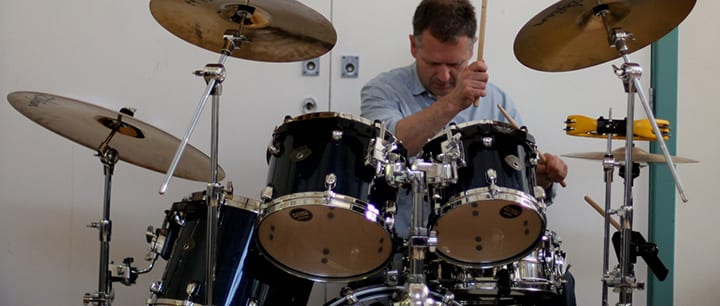Want to learn to play the drums? Nervous about the first lesson? Read on as San Diego, CA drum teacher Maegan W. shares what you can expect from a great first lesson…
Drums are an art form, and like all art forms, there are as many styles and techniques as there are people.
Each and every instructor has his or her own unique way and style of teaching. The key to learning and progressing as rapidly as possible is finding a teacher that you can relate to and understand. A good teacher will be able to quickly identify how you learn best, be it visually, audibly, or kinesthetically. Then he or she should adapt the lessons to your personal learning style.
This being said, there are a few basics that will almost always be included in any first lesson as you learn to play the drums.
Grip
Any good teacher will take a few minutes to make sure you have a proper grip and technique.
There are three main grips used in drumming:
- Matched German Grip (both palms facing down, sticks make a right angle, arms at sides)
- Matched French Grip (both hands with stick pinched between first finger and thumb, thumbs facing up, sticks making a right angle)
- Traditional Grip (right hand using French and/or German grip, and left hand holding stick like a fork or spoon)
The grip you use is a mix between personal preference and practicality. Some styles of music may call for one grip over another, as will certain playing positions, such as which drum or area of the set you are playing on.
Playing Techniques
There are many different playing techniques when it comes to the drums. It is good to try out as many as you can, and see which ones work best for you. Depending on your teacher, you will probably focus on just a few to start as you learn to play the drums. Techniques can take a long time to master, but substantial progress can be realized quickly with daily repetition.
Getting to Know the Drum Set
Next your teacher will most likely go around the kit and make sure you are familiar with all the different drums and cymbals, including their names, sounds, and uses. You’ll review how to properly use the pedals, along with foot techniques. Again, there are multiple foot techniques, and they can be used in combinations or by themselves depending on the situation.
Rudiments
Now you’re ready to start playing! There are 26 essential standard American rudiments as recognized by most drummers and by the Percussive Arts Society. All of them are important and have many uses and applications. Any proper drum instructor will start off with the basic five:
- Single Stroke Sticking/Roll Right hand lead = RLRL
- Single Stroke Sticking/Roll Left hand lead = LRLR
- Double Stroke Roll Right hand lead = RRLL
- Double Stroke Roll Left hand lead = LLRR
- Paradiddle = RLRR LRLL
These are the most well-known, foundational rudiments. These will be the basis of everything you play, from beginner level to advanced. A good teacher will not pass these by, and will encourage you to practice these everyday. It is important to drill these into your muscle memory.
Moving On
This will most likely conclude your first lesson. If you are a fast learner you may also get to go over some basic counting and timing exercises. Sometimes I will feel out what my students are more likely to be interested in, and give them their next exercise based on that. I may go into accents, which are volume levels known as dynamics, or I may go right into teaching a basic beat. It all depends on the student.
The most important thing to remember is that it is not about the destination, it is about the journey. Drums are such an amazing instrument, and they have such a huge depth of possibilities that you can spend your entire lifetime studying them, and still not know everything. That is what I love most.
I hope this was helpful, and that you’re no longer nervous about going to your first drum lesson. You can do it! Give yourself a chance and remember that drums are not easy, so don’t beat yourself up if you don’t get it right away. It’s all about practice, patience, and progress — not perfection. Enjoy the journey!
 Maegan W. teaches drums, songwriting, and more in San Diego, CA. She earned a degree in Percussion from the Musician’s Institute, and has been teaching private lessons since 2004. Learn more about Maegan here!
Maegan W. teaches drums, songwriting, and more in San Diego, CA. She earned a degree in Percussion from the Musician’s Institute, and has been teaching private lessons since 2004. Learn more about Maegan here!
 Photo by Martin Hesketh
Photo by Martin Hesketh
Suzy S.

